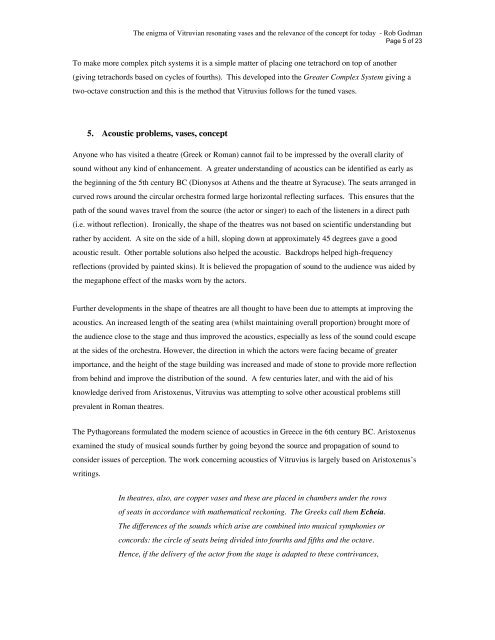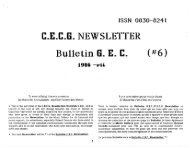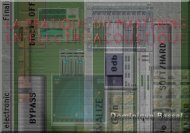The enigma of Vitruvian resonating vases and the relevance ... - CEC
The enigma of Vitruvian resonating vases and the relevance ... - CEC
The enigma of Vitruvian resonating vases and the relevance ... - CEC
You also want an ePaper? Increase the reach of your titles
YUMPU automatically turns print PDFs into web optimized ePapers that Google loves.
<strong>The</strong> <strong>enigma</strong> <strong>of</strong> <strong>Vitruvian</strong> <strong>resonating</strong> <strong>vases</strong> <strong>and</strong> <strong>the</strong> <strong>relevance</strong> <strong>of</strong> <strong>the</strong> concept for today - Rob Godman<br />
Page 5 <strong>of</strong> 23<br />
To make more complex pitch systems it is a simple matter <strong>of</strong> placing one tetrachord on top <strong>of</strong> ano<strong>the</strong>r<br />
(giving tetrachords based on cycles <strong>of</strong> fourths). This developed into <strong>the</strong> Greater Complex System giving a<br />
two-octave construction <strong>and</strong> this is <strong>the</strong> method that Vitruvius follows for <strong>the</strong> tuned <strong>vases</strong>.<br />
5. Acoustic problems, <strong>vases</strong>, concept<br />
Anyone who has visited a <strong>the</strong>atre (Greek or Roman) cannot fail to be impressed by <strong>the</strong> overall clarity <strong>of</strong><br />
sound without any kind <strong>of</strong> enhancement. A greater underst<strong>and</strong>ing <strong>of</strong> acoustics can be identified as early as<br />
<strong>the</strong> beginning <strong>of</strong> <strong>the</strong> 5th century BC (Dionysos at A<strong>the</strong>ns <strong>and</strong> <strong>the</strong> <strong>the</strong>atre at Syracuse). <strong>The</strong> seats arranged in<br />
curved rows around <strong>the</strong> circular orchestra formed large horizontal reflecting surfaces. This ensures that <strong>the</strong><br />
path <strong>of</strong> <strong>the</strong> sound waves travel from <strong>the</strong> source (<strong>the</strong> actor or singer) to each <strong>of</strong> <strong>the</strong> listeners in a direct path<br />
(i.e. without reflection). Ironically, <strong>the</strong> shape <strong>of</strong> <strong>the</strong> <strong>the</strong>atres was not based on scientific underst<strong>and</strong>ing but<br />
ra<strong>the</strong>r by accident. A site on <strong>the</strong> side <strong>of</strong> a hill, sloping down at approximately 45 degrees gave a good<br />
acoustic result. O<strong>the</strong>r portable solutions also helped <strong>the</strong> acoustic. Backdrops helped high-frequency<br />
reflections (provided by painted skins). It is believed <strong>the</strong> propagation <strong>of</strong> sound to <strong>the</strong> audience was aided by<br />
<strong>the</strong> megaphone effect <strong>of</strong> <strong>the</strong> masks worn by <strong>the</strong> actors.<br />
Fur<strong>the</strong>r developments in <strong>the</strong> shape <strong>of</strong> <strong>the</strong>atres are all thought to have been due to attempts at improving <strong>the</strong><br />
acoustics. An increased length <strong>of</strong> <strong>the</strong> seating area (whilst maintaining overall proportion) brought more <strong>of</strong><br />
<strong>the</strong> audience close to <strong>the</strong> stage <strong>and</strong> thus improved <strong>the</strong> acoustics, especially as less <strong>of</strong> <strong>the</strong> sound could escape<br />
at <strong>the</strong> sides <strong>of</strong> <strong>the</strong> orchestra. However, <strong>the</strong> direction in which <strong>the</strong> actors were facing became <strong>of</strong> greater<br />
importance, <strong>and</strong> <strong>the</strong> height <strong>of</strong> <strong>the</strong> stage building was increased <strong>and</strong> made <strong>of</strong> stone to provide more reflection<br />
from behind <strong>and</strong> improve <strong>the</strong> distribution <strong>of</strong> <strong>the</strong> sound. A few centuries later, <strong>and</strong> with <strong>the</strong> aid <strong>of</strong> his<br />
knowledge derived from Aristoxenus, Vitruvius was attempting to solve o<strong>the</strong>r acoustical problems still<br />
prevalent in Roman <strong>the</strong>atres.<br />
<strong>The</strong> Pythagoreans formulated <strong>the</strong> modern science <strong>of</strong> acoustics in Greece in <strong>the</strong> 6th century BC. Aristoxenus<br />
examined <strong>the</strong> study <strong>of</strong> musical sounds fur<strong>the</strong>r by going beyond <strong>the</strong> source <strong>and</strong> propagation <strong>of</strong> sound to<br />
consider issues <strong>of</strong> perception. <strong>The</strong> work concerning acoustics <strong>of</strong> Vitruvius is largely based on Aristoxenus’s<br />
writings.<br />
In <strong>the</strong>atres, also, are copper <strong>vases</strong> <strong>and</strong> <strong>the</strong>se are placed in chambers under <strong>the</strong> rows<br />
<strong>of</strong> seats in accordance with ma<strong>the</strong>matical reckoning. <strong>The</strong> Greeks call <strong>the</strong>m Echeia.<br />
<strong>The</strong> differences <strong>of</strong> <strong>the</strong> sounds which arise are combined into musical symphonies or<br />
concords: <strong>the</strong> circle <strong>of</strong> seats being divided into fourths <strong>and</strong> fifths <strong>and</strong> <strong>the</strong> octave.<br />
Hence, if <strong>the</strong> delivery <strong>of</strong> <strong>the</strong> actor from <strong>the</strong> stage is adapted to <strong>the</strong>se contrivances,








